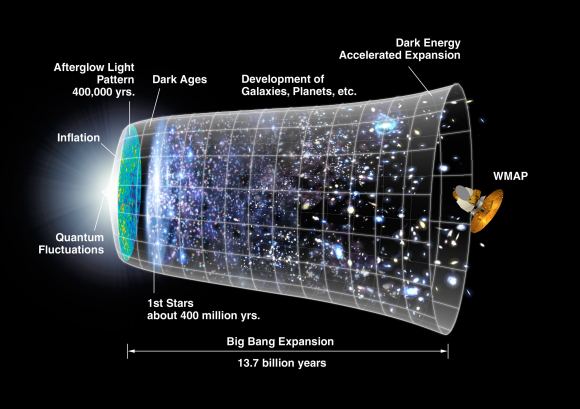The Multiverse Theory, which states that there may be multiple or even an infinite number of Universes, is a time-honored concept in cosmology and theoretical physics. While the term goes back to the late 19th century, the scientific basis of this theory arose from quantum physics and the study of cosmological forces like black holes, singularities, and problems arising out of the Big Bang Theory.
One of the most burning questions when it comes to this theory is whether or not life could exist in multiple Universes. If indeed the laws of physics change from one Universe to the next, what could this mean for life itself? According to a new series of studies by a team of international researchers, it is possible that life could be common throughout the Multiverse (if it actually exists).
The studies, titled “The impact of dark energy on galaxy formation. What does the future of our Universe hold?” and “Galaxy formation efficiency and the multiverse explanation of the cosmological constant with EAGLE simulations“, recently appeared in the Monthly Notices of the Royal Astronomical Society. The former study was led by Jaime Salcido, a postgraduate student at Durham University’s

This accelerate rate of expansion, which is an integral part of the Lambda-Cold Dark Matter (Lambda-CDM) model of cosmology, arose out of problems posed by Einstein’s Theory of General Relativity.
As a consequence of Einstein’s field equations, physicist’s understood that the Universe would either be in a state of expansion or contraction since the Big Bang. In 1919, Einstein responded by proposing the “Cosmological Constant” (represented by Lambda), which was a force that “held back” the effects of gravity and thus ensured that the Universe was static and unchanging.
Shortly thereafter, Einstein retracted this proposal when Edwin Hubble revealed (based on redshift measurements of other galaxies) that the Universe was indeed in a state of expansion. Einstein apparently went as far as to declare the Cosmological Constant “the biggest blunder” of his career as a result. However, research into cosmological expansion during the late 1990s caused his theory to be reevaluated.

In short, ongoing studies of the large-scale Universe revealed that during the past 5 billion years, cosmic expansion has accelerated. As such, astronomers began to hypothesize the existence of a mysterious, invisible force that was driving this acceleration. Popularly known as “Dark Energy”, this force is also referred to as the Cosmological Constant (CC) since it is responsible for counter-effecting the effects of gravity.
Since that time, astrophysicists and cosmologists have sought to understand how Dark Energy could have effected cosmic evolution. This is an issue since our current cosmological models predict that there must be more Dark Energy in our Universe than has been observed. However, accounting for larger amounts of Dark Energy would cause such a rapid expansion that it would dilute matter before any stars, planets or life could form.
For the first study, Salcido and the team therefore sought to determine how the presence of more Dark Energy could effect the rate of star formation in our Universe. To do this, they conducted hydrodynamical simulations using the EAGLE (Evolution and Assembly of GaLaxies and their Environments) project – one of the most realistic simulations of the observed Universe.
Using these simulations, the team considered the effects that Dark Energy (at its observed value) would have on star formation over the past 13.8 billion years, and an additional 13.8 billion years into the future. From this, the team developed a simple analytic model that indicated that Dark Energy – despite the difference in the rate of cosmic expansion – would have a negligible impact on star formation in the Universe.

They further showed that the impact of Lambda only becomes significant when the Universe has already produced most of its stellar mass and only causes decreases in the total density of star formation by about 15%. As Salcido explained in a Durham University press release:
“For many physicists, the unexplained but seemingly special amount of dark energy in our Universe is a frustrating puzzle. Our simulations show that even if there was much more dark energy or even very little in the Universe then it would only have a minimal effect on star and planet formation, raising the prospect that life could exist throughout the Multiverse.”
For the second study, the team used the same simulation from the EAGLE collaboration to investigate the effect of varying degrees of the CC on the formation on galaxies and stars. This consisted of simulating Universes that had Lambda values ranging from 0 to 300 times the current value observed in our Universe.
However, since the Universe’s rate of star formation peaked at around 3.5 billion years before the onset of accelerating expansion (ca. 8.5 billion years ago and 5.3 billion years after the Big Bang), increases in the CC had only a small effect on the rate of star formation.
Taken together, these simulations indicated that in a Multiverse, where the laws of physics may differ widely, the effects of more dark energy cosmic accelerated expansion would not have a significant impact on the rates of star or galaxy formation. This, in turn, indicates that other Universes in the Multiverse would be just about as habitable as our own, at least in theory. As Dr. Barnes explained:
“The Multiverse was previously thought to explain the observed value of dark energy as a lottery – we have a lucky ticket and live in the Universe that forms beautiful galaxies which permit life as we know it. Our work shows that our ticket seems a little too lucky, so to speak. It’s more special than it needs to be for life. This is a problem for the Multiverse; a puzzle remains.”
However, the team’s studies also cast doubt on the ability of Multiverse Theory to explain the observed value of Dark Energy in our Universe. According to their research, if we do live in a Multiverse, we would be observing as much as 50 times more Dark Energy than what we are. Although their results do not rule out the possibility of the Multiverse, the tiny amount of Dark Energy we’ve observed would be better explained by the presence of a as-yet undiscovered law of nature.
As Professor Richard Bower, a member of Durham University’s Institute for Computational Cosmology and a co-author on the paper, explained:
“The formation of stars in a universe is a battle between the attraction of gravity, and the repulsion of dark energy. We have found in our simulations that Universes with much more dark energy than ours can happily form stars. So why such a paltry amount of dark energy in our Universe? I think we should be looking for a new law of physics to explain this strange property of our Universe, and the Multiverse theory does little to rescue physicists’ discomfort.”
These studies are timely since they come on the heels of Stephen Hawking’s final theory, which cast doubt on the existence of the Multiverse and proposed a finite and reasonably smooth Universe instead. Basically, all three studies indicate that the debate about whether or not we live in a Multiverse and the role of Dark Energy in cosmic evolution is far from over. But we can look forward to next-generation missions providing some helpful clues in the future.
These include the James Webb Space Telescope (JWST), the Wide Field Infrared Survey Telescope (WFIRST), and ground-based observatories like the Square Kilometer Array (SKA). In addition to studying exoplanets and objects in our Solar System, these mission will be dedicated to studying how the first stars and galaxies formed and determining the role played by Dark Energy.
What’s more, all of these missions are expected to be gathering their first light sometime in the 2020s. So stay tuned, because more information – with cosmological implications – will be arriving in just a few years time!
Further Reading: Durham University

